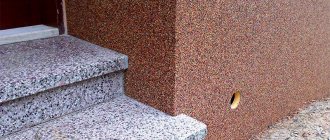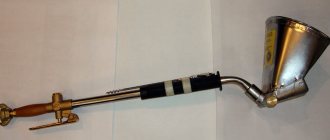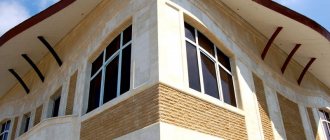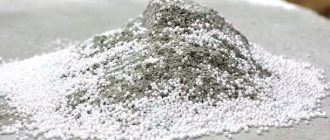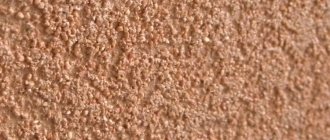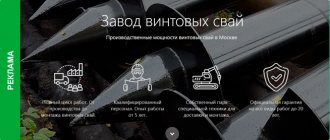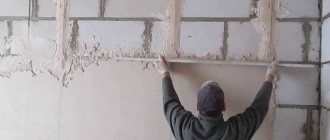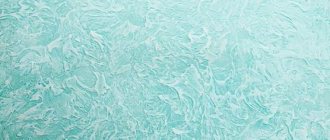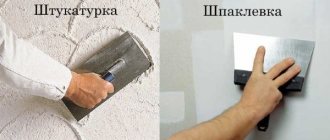People say that repairs are like a fire. Therefore, homeowners try to use reliable, durable materials. One of these is elastic plaster, the use of which helps solve several problems at the same time. The flexible, tensile coating does not crack when the house shrinks, does not allow water to pass through to the structures it protects, and strengthens weak foundations while serving as a decorative feature.
Description and history of appearance
It would seem that everyone is happy with classic mineral plasters. However, they are not able to withstand vibrations from nearby trains, weak seismic influences and slight shrinkage of the building. They once earned recognition for their non-shrinkability during hardening. In fact, they are low-elastic, and, unable to withstand such operating conditions, they quickly become covered with cracks and cease to serve as protection for the building’s structures.
In the middle of the twentieth century, chemists invented artificial resins, among which acrylic resins stand out for their flexibility after hardening. Acrylic resin can absorb up to 70% of the filler.
The created modified acrylic liquid began to be used not only in the production of plastic, but also to create artificial stone. And artists began to experiment with creating paints based on it. The composition of such paints was simple: water, acrylic, pigment. To obtain a plaster solution, all that remained was to add a mineral filler.
The mixtures obtained on an acrylic basis formed a flexible, elastic coating that did not crack during the shrinkage of the building, which solved the problem of protecting the walls. It remained to slightly modify the composition using functional additives in order to eliminate the existing shortcomings.
This plaster was quickly dubbed rubber. The coating can be bent and slightly stretched up to 10% of the initial length without compromising its integrity. Later, silicone-based compositions began to be produced, however, elastic plasters have an acrylic base.
Fillers for elastic composition of natural or artificial origin:
- sand (including quartz);
- fibers;
- stone chips;
- granules.
The appearance of the elastic coating, depending on the filler used, may resemble plaster or other textures of decorative solutions. Elastic mixtures are available in ready-made or dry form. They can be tinted or serve as a base for tinting.
What it is?
Elastic material for finishing the walls of a building is made with the addition of acrylic resins. Cement can also act as a binding component. Thanks to polymer inclusions, the coating stretches or contracts without cracking when the base is deformed. Elastic plaster for facades is produced with the addition of artificial or natural fillers. Use quartz sand, marble or granite chips.
The material helps protect the walls of the structure during its shrinkage. It also performs a decorative function and strengthens the base. The plaster is sold in a ready-to-use form, so you don’t have to mix the composition yourself.
Advantages
Flexible plaster does not contain toxic substances and is therefore environmentally friendly. It does not have a pungent or unpleasant odor. The material also has the following advantages:
- high level of adhesion to the base (the composition does not fall off the wall regardless of the factors influencing it);
- versatility (used for cladding internal and external surfaces);
- possibility of use on any type of base;
- high degree of vapor permeability, which ensures a good microclimate in the room and prevents the accumulation of moisture;
- resistance of the coating to direct sunlight, water, negative temperatures;
- setting speed: it takes only 2 days for the material to gain final strength, and further finishing work can be carried out after 12 hours;
- ease of application (all work is carried out independently and does not require special knowledge or skills);
- durability;
- ease of maintenance (the layer is not susceptible to dirt absorption).
Elastic plaster can be painted. In this case, it is better to use an acrylic-based composition. No special equipment or expensive tools are required to apply the substance.
Flaws
The only significant drawback of this type of finishing is its high cost, so it is often purchased for interior decoration of small areas.
Elastic plaster: advantages and disadvantages
Main advantages:
- compressibility and extensibility without compromising the integrity of the coating;
- forms a coating without seams;
- vapor permeability, allowing the wall material to breathe;
- no toxic emissions;
- the service life of a properly executed coating is more than 10 years;
- fire resistance;
- temperature limits from -50 to +60°C;
- color fastness, not afraid of UV rays;
- quick drying;
- serves as barriers to fungi and mold;
- easy to clean with plain water;
- adheres well to almost all substrates (this is especially valuable for “playing” wooden structures);
- universal application;
- easy to apply and shape;
- hydrophobic, protects walls from water ingress;
- does not dry out the skin (you can work without gloves);
- does not splash when applied to the wall, does not drip from the spatula;
- Suitable for repairing cracked walls and finishing new buildings.
The downside so far is the high cost.
Properties and scope of application
Modification of plaster compositions is necessary to improve the physical and mechanical properties and better adhesion of the plaster layer to the base. Plus, they are perfect for decorative finishing, as they come in many varieties in texture and color. The main properties are the following:
- Vapor permeability.
- Frost resistance.
- Hydrophobicity.
- Water resistance.
- Impact resistance.
- Plastic.
- Environmentally friendly.
Polymer plasters form a thin decorative coating and are used for both interior and exterior work. Suitable for concrete, plasterboard, cement-sand bases. They are often used for finishing basements and facades, as well as for interior finishing of walls of houses, administrative buildings, and public premises.
Specifications
Flexible plaster, in addition to other technical characteristics inherent in finishing compositions, has a new one - linear stretching.
On average, the technical parameters are as follows:
- density – not less than 1400 kg/m3;
- adhesion (in relation to concrete) > 0.3MPa;
- compressive strength, expansion strength – 7 bar;
- final strength is gained after 3 days;
- linear stretch from +10% per sq.m;
- contains more than 50% non-volatile substances;
- consumption – 0.3-2.8 kg/m2;
- air and base temperature during application + 5, + 30°C; during operation -50, +60 °C;
- frost resistance - more than 150 cycles;
- salt resistance ~ 300 hours of exposure;
- water permeability – less than 8g/hour per square meter;
- service life more than 10 years.
Flaws
The only important drawback, which turns out to be decisive for many, is the cost of this plaster. Despite the fact that not only foreign, but also domestic samples are presented on the market today, flexible plaster is still much more expensive than regular plaster (not counting decorative options, the price of which can vary greatly). For this reason, if such a composition is purchased more often for interior decoration, including decorative, then large-scale facade work in this case can be quite expensive.
Where is elastic plaster used?
The elasticity of the coating serves as the basis for choosing these particular compositions for buildings experiencing vibration, as well as for new buildings that have not yet gone through a period of shrinkage. Taking into account the hydrophobic properties, flexible plaster is preferable for facades, as well as wet rooms, for example, bathrooms, basements, baths, swimming pools.
The ability not only to stretch, but also to shrink, makes it popular for use on landings, corridors, and halls. Elastic compositions are good for finishing finishing when insulating buildings using wet (plaster) systems.
Most often, elastic plaster is produced and used as facade plaster. However, as can already be understood from the above, it is also successfully used for interior work. It can be used to cover gypsum stucco with a thin layer, as well as figured products made of polyurethane or polystyrene foam. The rubber compound is also used to cover walls that have many joints, seams and joints, for example, made of CBPB, creating a seamless coating. Can be used as an adhesive base for linoleum, parquet, and carpet.
Pros and cons of using acrylate finishing composition
Polymer plaster has a large number of advantages. Among them:
- resistance to thermal expansion and contraction, vibration, shock, pollutants and moisture;
- relatively easy to apply;
- all-season;
- vapor and air permeability;
- environmental friendliness and safety of the acrylate mixture;
- richness of textures;
- visual appeal and aesthetics of treated surfaces.
The main disadvantages of elastic finishing material include: high price compared to other types of similar dry and ready-made mixtures; requirement of a flat base for finishing; Depending on the base material, it is sometimes necessary to pre-treat it with a primer. At the same time, increased spending will pay off with interest.
The consumption of elastic plaster for interior work is small due to the small thickness of the applied layer. And facade finishing of the same type will pay off due to increased resistance to wear, durability and independence from the base material being processed.
Flexible plaster is used as a membrane for the final finishing of surfaces both inside and outside a building or residential building. The product is ideal for applications where strong adhesion, stretch/compression, moisture and time resistance are required.
It is recommended to use flexible finishing material indoors with high humidity: bathrooms, toilets, swimming pools, showers, etc.
Elastic facade plaster creates a protective coating over the entire surface of the wall, which prevents the harmful effects of moisture, snow, frost and intense sunlight. Flexible plaster for facades firmly adheres to the wall surface and fits over uneven surfaces like a rubber shell. At the same time, the appearance of a wall with such a finish retains its attractiveness and aesthetics for up to 10 years or more with proper use. Suitable for finishing parts of frame structures.
Types of elastic plasters
Rubber plaster is available in two types:
- decorative;
- acrylic.
The main task of the acrylic mixture is to protect walls and other structures. It also maintains the integrity and continuity of the coating (which is ensured by acrylic base polymers). The task of decorative flexible plaster is different. It is also intended for decorating various surfaces. This effect is achieved due to the shape and size of the filler grains (with simple even application), as well as by methods of treating the surface of the applied layer.
Mixtures with filler of different fractions are produced, as well as mixtures with reinforcing polymer threads.
Possible decorative effects of coatings:
- fur coat;
- imitation gypsum;
- lamb;
- bark beetle and others.
You can use tinted compounds to decorate walls using the sgraffito technique. Patterned relief is applied with figured rollers or other devices.
Tips and tricks for selecting a mixture
Cement-sand mortar can be made by selecting and measuring the components yourself. It will cost much less. Or you can buy a ready-made dry mixture. When choosing, they are guided by the type of coating, operating conditions, base material, labor costs, and cost.
Some selection rules:
- To decorate the external surfaces of buildings, CPS and CIS compositions for facade work, or universal ones, are used.
- All types of DSP and CIS are suitable for premises, but the optimal ones are those that are intended specifically for the interior.
- For rooms with high humidity, compositions without lime are used. For dry rooms, CIS may be preferable, as they create the most favorable conditions.
- For work in winter, mixtures with antifreeze additives are used.
- According to special requirements (reduce noise levels, insulate walls, etc.), special compositions are used.
- For wooden surfaces it is better to take CIS.
- The specified maximum permissible layer thickness is taken into account if a thick leveling coating is required. This indicator is related to the duration of work.
- Gypsum-containing walls as a base are not suitable for all ready-made mixtures.
- It is better to purchase mixtures from those manufacturers who have proven themselves to be of high quality products.
The “correct” mixtures are packaged in three-layer bags made of paper and film. They do not have the same release time (they must differ by at least a second). It is better to purchase mixtures that have been produced recently.
Since there is a possibility of purchasing a fake, it is better to play it safe, buy a couple of bags of the mixture, and try it out. If the setting times stated on the packaging are met experimentally, the plaster mixture has a normal consistency, and the coating has the required surface quality, you can purchase the remaining quantity.
Surface primer
Before priming the surface of the wall, it must be cleaned of old coating: wallpaper, oil paints, whitewash. After all, if you leave them, the new coating will not have reliable adhesion to the wall, and the plaster will fall off.
Removing the old coating also helps to identify the presence of defects. After removing the coating, the wall is vacuumed to remove dust. The protrusions are cut down, chips and cracks are covered. Large damages are repaired using reinforcing mesh. Oil stains must be removed. Fungal and mold outbreaks are also removed. For this purpose, biocidal solutions are used. Metal parts are coated with insulating compounds. The screws securing the DSP boards to the wall are recessed by 1-2 mm.
Wall materials, such as concrete, brick, foam blocks, are full of small and large pores. To prevent them from drawing out the water that the plaster needs for hardening reactions to occur, as well as to obtain reliable adhesion, they are coated with primer compounds twice with intermediate drying. After the primer has dried, if it is necessary to level the surface of the base, it is puttied (minimum thickness - 2 mm), or plastered over the beacons.
If there are joints on the wall (for example, DSP boards or insulation), then they are sealed with elastic sealants and the surface of the seams is leveled with the surface of the boards.
Tips and tricks
Most homeowners prefer budget renovations, in which the bulk of the construction work is done with their own hands. Plastering walls is no exception to this.
This process is not difficult, but in order to do everything correctly, the following recommendations from experienced craftsmen can help:
- Only those walls that have significant defects and unevenness need to be plastered. This will help not only speed up repairs, but also save money on finishing. Therefore, the surfaces are first checked, and if the lighting falls on them at an oblique angle, then leveling is done. It is also necessary to cover with the solution those walls on which you plan to attach the skirting boards.
- You can ensure good durability of the coating using a primer made from water and PVA glue.
- If the plaster is applied to brickwork and the room temperature exceeds 23°C, then its base should be thoroughly moistened.
When leveling walls, it is advisable to use beacons; they allow you to set the correct level and determine the optimal thickness of the finish. If the base is single-layer, it must be leveled immediately after coating with the solution. You can also use special trowels for this; they are used after the coating has set on the surface.
If the finishing involves a second layer, then it is important to wait until the solution of the first layer sets. Gypsum sheets allow you to make high-quality plastering of walls. They are suitable in cases where it is necessary to level very large areas of the room, since constant preparation of the solution can slow down the work
The mixture hardens quickly and can no longer be used. Before plastering begins, the working area must be calculated and the level of all differences and slopes determined. Thanks to such calculations, it is possible to calculate the material consumption in advance and draw up estimates.
Small and large cracks may appear after finishing if the solution is poorly mixed or dries quickly under the influence of drafts. Therefore, the mixture should be thoroughly mixed and plastered only in enclosed spaces. In addition, the surface must be well sanded, and if the mixture is applied in several layers, then a construction mesh should be used. Putty allows you to eliminate only minor irregularities reaching 5 mm, since its layer cannot exceed 5 cm. Therefore, if the walls have large differences, then it is best to first hide them under drywall, and then apply the mixture
It is also important to carry out calculations of the geometry of the room and make all angles 90°, since unevenness and curvature will cause inconsistencies in the wallpaper and the formation of an incorrect slope above the cabinets. Gypsum plaster should be purchased taking into account the climatic conditions in the room. If there is a constant temperature difference and high humidity, then it is necessary to give preference to special types of mixture.
For information on plastering walls with gypsum mixture, see the following video.
Surface reinforcement
Elastic plaster is usually applied in a thin layer, so the surface of the base is covered with cement mortar. If you need to make the leveling layer durable, use reinforcement mesh.
Basic rules for installing a grid:
- fasten to the wall using dowels or an adhesive solution, making sure that there are no sagging (where sagging is left, air pockets appear under the plaster);
- the mesh panels are connected by overlapping the joined edges;
- after fixing the grid, beacons are installed;
- apply a leveling solution and level;
- after the beginning of setting, the beacon strips are removed and the remaining grooves are sealed.
stirring the mixture
installation of reinforcing mesh
applying elastic plaster
result of applying elastic plaster
Materials and tools
To decorate facades and interior walls with decorative plastic plaster, you will need materials such as primer, putty or silicone sealant. If the surface roughness is high, it is additionally ground using coarse sandpaper or a special mesh. Reinforcing mesh may also be needed to provide greater strength to the finished surface.
To work with flexible plaster, you need the most common tools: a spatula for applying and leveling, a plastic trowel for grouting. The diluted composition can be applied using a spray gun. It is faster to process a rough base with a grinding machine, but it can also be done manually. To apply the sealant, a “gun” is used, which is usually included in the kit. Paint and primer are applied with a brush or roller. To clean brushes, rollers and reusable containers, simply rinse them with plain water.
Application of elastic plaster for facades
Always from the center of the wall towards the edges - from wet to dry, as well as wet to wet - this is the basic rule for applying elastic compounds.
Before starting work, stir the finished mixture (if bubbles form, the solution is allowed to settle). The dry mixture is kneaded following the manufacturer's instructions (see instructions).
Elastic plaster is applied manually or using a plastering machine. In both cases, the wall is processed completely in one go. There should be no breaks.
For manual application, the rubber compound is applied to the base by positioning the trowel or putty knife plate at a 60-degree angle to the wall. When the laid mortar stops sticking to the tool, it is smoothed or structured with a trowel, holding it parallel to the layer.
Smoothing with a spatula or trowel after half an hour leads to the formation of a glossy surface. This is how a coating similar to Venetian is made. The solution is applied in two or three layers (the first is continuous, the next two are applied in separate strokes using the Venetian technique).
During the decorative treatment of the layer, as well as during the drying period, the layer cannot be moistened.
Another way to apply a flexible solution is to roll it with a textured roller. It is carried out from the bottom up, then rolled horizontally to evenly distribute the mixture on the wall.
Rubber solutions quickly set and polymerize. Therefore, work on large areas is carried out in teams. If two people are plastering a wall, then they move from the corners of the wall towards the center (toward each other).
Tools and parts of the plastering machine are washed with water after use.
Paint the surface with acrylic paints after the rubber layer has dried.
If you plan to purchase already painted mortar, then purchase the material from one batch so that the entire wall is the same color. Lots may differ in shades.
Application conditions
To obtain a durable, strong and wear-resistant elastic coating, plastering is carried out taking into account the following requirements:
- the workplace must be protected from sunlight, wind, and precipitation;
- air temperature is optimal within +5…+30°C;
- air humidity level - not less than 80%;
- The plastic material does not mix with putty or inappropriate dyes.
Required materials and tools
The work will require the following tools:
- spatulas;
- stainless steel trowel;
- plastic grater;
- figured rollers;
- brushes;
- capacity;
- construction mixer with attachment, etc.
In addition to plastic plaster, a primer mixture and putty can be used to seal cracks and tile joints. For painting, you need paint or color, which is poured into the plaster solution. To determine the volume of the mixture, it is necessary to take into account the consumption of elastic material (1.7-3 kg per 1 m²).
Surface primer
It is recommended to prepare the area before applying plaster. The wall is leveled, protrusions are removed, areas with mold are cleaned and treated with antiseptic compounds. The old coating is removed. Then the base is primed. This layer improves adhesion to finishing materials and increases the service life of the repair.
The primer is applied once to a smooth, flat surface. For a porous base with deformations, 2-3 layers of soil are required. Each coating is dried.
Surface reinforcement
If there are large irregularities in the area, the wall is reinforced after priming. It is optimal to use fiberglass fabric, which is fixed to an adhesive base or using dowels. The joints of the canvases are overlapped. The mesh is carefully stretched before the procedure to prevent deformation.
After tightly fixing the reinforced mesh, beacon strips are set and a leveling layer of plaster is applied. The mass is thrown onto the mesh to increase the adhesion of the base. After one layer has dried, the surface is coated again with a primer solution and dried.
Applying plaster to the facade
After leveling the base, elastic facade plaster is applied. Dry material is diluted with water in compliance with the proportions specified by the manufacturer. The finished mixture is stirred in a container. The work is carried out with a spatula or trowel.
The composition is applied from the center of the base to the edge. The layer of material should be no more than 5 mm and no less than 1.3 mm. The coating is carried out in 1-2 thin layers. The work is carried out promptly, because the solution hardens quickly. When applied, the mixture is leveled, then sanded to give a smooth surface. Irregularities are removed with a spatula until the coating dries.
At the final stage, these areas are painted or decorated with a graphic design or painting. Decoration is done with a textured roller until the plaster layer dries.
Leading manufacturers
Elastic plaster for facades, as well as interiors, is supplied to the market by Russian and foreign manufacturers.
The following compositions can be distinguished:
- i-Flex is a universal-purpose elastomeric ready-made decorative mixture with a filler fraction of 0.7-1.2 mm. The coating can stretch up to 15%. Manual/mechanical application. Bayramix.
- ST-79 is an elastomeric decorative pebble composition for plinths, parking lots, garage entrances, reinforced with a complex of polyacrylamide, carbon fibers, and also fiberglass. The composition contains silicone modifiers. Grain 1.5 mm. Extended operating temperature range. Zeresit.
- Capa-Rollputz-Flex is a ready-made façade mortar with a grain size of 0.4-1.5 mm. Caparol.
- Multiflex - two types Nano and Nano lux - ready-made decorative, waterproofing compounds for universal use. These materials are distinguished by their tensile strength (106% nano, 200% nanolux) and adhesion to concrete – 1.6 MPa. White color. Application by brush or roller. Suitable for covering swimming pool bowls. Polymer Megapolis.
How to prepare plaster
At home, you can prepare any type of plaster mixture yourself. Let's make the simplest one on a cement base.
Step 1. First of all, we prepare all the necessary tools and components: sifted river sand, cement, water, detergent, a container in which we will mix the mixture, as well as a mixer with which we will mix.
Preparing everything you need
Attention! Detergent is used to prevent the mixture from shrinking too much during drying.
Step 2. Add a couple of caps of detergent to a bucket of water. Stir with a mixer.
Adding detergent
Water mixed with detergent
Step 3. Pour the finished liquid evenly into the sand placed in a wooden stretcher.
The finished liquid is poured into the sand
Step 4. Using a construction mixer again, mix the sand and the soap mixture poured into it. The solution should reach a mushy state.
The components are mixed
Attention! We add water gradually - there is no need to pour out the whole bucket at once, so as not to make the mixture too liquid.
Step 5. Spread the cement evenly over the surface of the mixture in a stretcher.
Cement is added
Step 6. Mix the mixture with a mixer and add a little water again. Mix the mixture again with a mixer. Using a spatula, remove dried pieces of mortar from the walls of the stretcher and mix them in a “common cauldron.”
Re-mixing ingredients
The plaster solution is ready and can be used for finishing.
Advice! It is advisable to sift all materials that will be used to prepare plaster through a sieve. This procedure will achieve a more uniform consistency.
Video - Preparation of plaster solution
Operational care
The elastic cover is easy to use. The flexible coating does not attract dust, resulting in virtually no contamination. Therefore, the surface does not need to be cleaned frequently. Wash the walls with plain water or soap and water. For cleaning, use a cloth, sponge or nylon brush.
By using elastic plaster for the facades and/or interiors of a house, they solve a number of problems at once: they protect the walls from water penetration, strengthen the weak surface of the insulation, and decorate the room or facade. The remaining solution can be used for gluing parquet or linoleum.
Preparing concrete walls for plastering
The process of preparing interior concrete walls for plastering consists of the following steps:
- The old coating in the form of fragile plaster, whitewash, paint is removed (in which cases it is possible to apply plaster over old paint, we recommend reading here);
- Defects in concrete walls are determined. If there are nodules, they are cut down using a hammer and chisel. Massive chips and deep cavities are sealed with cement-sand mortar in a ratio of 1:3; if necessary, steel mesh is used for reinforcement;
- On smooth walls, notches are made using a hammer and chisel, the maximum notch spacing is 10 cm;
- If it is necessary to install hidden wiring, grooves are made for the wires;
- The concrete surface is cleaned. A brush and water are used to remove dust and dirt. The wall can be treated using compressed air or a strong jet of water, which will significantly speed up the cleaning process;
- A primer is applied to the wall surface.
